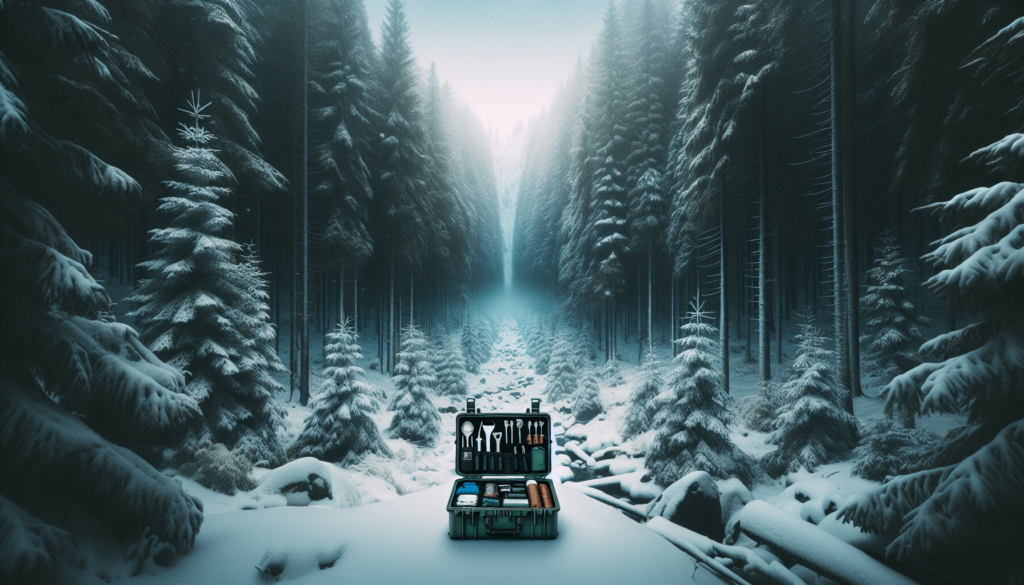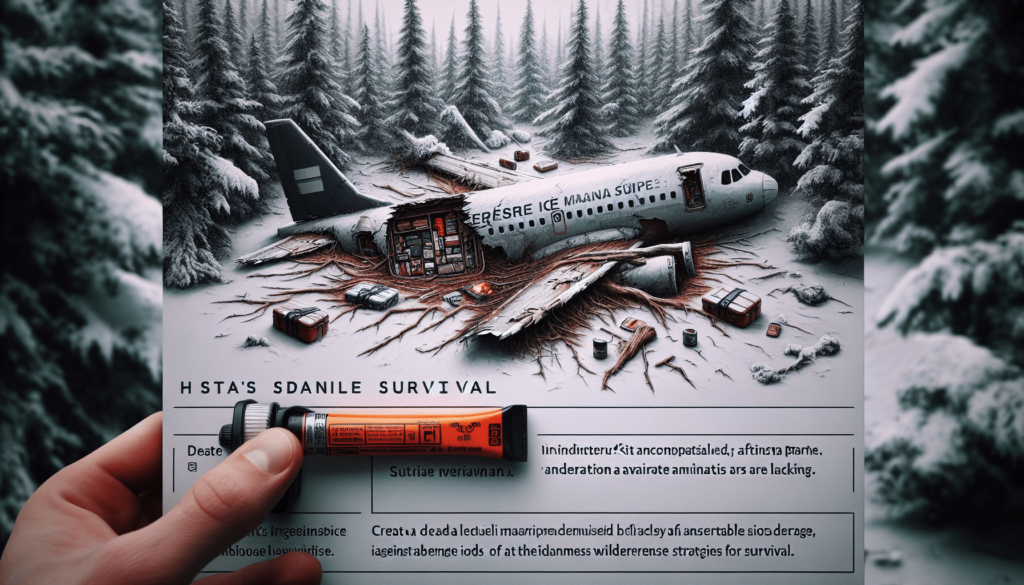Are you an outdoor enthusiast or someone who simply wants to be prepared for any situation? If so, then you understand the importance of wilderness survival skills. Whether it’s lighting a fire or finding food and water, knowing these skills can make the difference between a challenging experience and a life-threatening one. That’s where my blog, “The Survivalist Handbook,” comes in. With its comprehensive collection of articles under the “Wilderness Survival” category, you can learn everything you need to know to thrive in any wilderness environment. So get ready to become a master of the wilds and prepare yourself for the unexpected, starting with surviving a plane crash.

Assessing the Situation
When disaster strikes and you find yourself in a wilderness survival situation, the first step is to assess your surroundings. Take a moment to evaluate your immediate surroundings and identify any potential threats or dangers. Look out for hazardous terrain, unstable structures, or dangerous wildlife.
Next, check yourself and others for any injuries. Attend to any immediate medical needs, such as stopping bleeding or stabilizing broken bones. Remember to prioritize your own safety and well-being before attempting to help others.
Once you have assessed the immediate dangers and checked for injuries, it is important to identify any immediate threats. This could include factors such as a spreading fire, an impending storm, or wild animals in the area. By identifying these threats, you can prioritize your actions and take appropriate measures to ensure your safety.
Finding Shelter
In a wilderness survival situation, finding or creating suitable shelter is crucial for protection from the elements and maintaining body temperature. Start by searching for natural shelters, such as caves, overhanging rock formations, or dense foliage. These natural shelters can provide a quick and effective way to protect yourself.
If natural shelters are not available, you can create makeshift shelters using the resources around you. Look for materials like branches, leaves, and debris to construct a shelter. Consider the weather conditions when building your shelter – ensure it is sturdy enough to withstand wind, rain, or snow.
Remember that staying dry is of utmost importance to avoid hypothermia, so be sure to insulate your shelter from the ground using natural materials like leaves or grass. By finding or creating a suitable shelter, you will greatly increase your chances of survival in the wilderness.
Starting a Fire
A fire is not only a source of warmth, but it also provides light, a means of cooking food, and a way to signal for help. To start a fire, begin by gathering firewood and tinder. Look for dry and dead branches, twigs, and leaves to use as fuel. Collect as much firewood as you can, ensuring you have enough to sustain the fire throughout the night.
Choose a suitable location for your fire, preferably in an open area away from any flammable materials. Clear the area around the fire to prevent any accidental spread of flames. It is also essential to consider wind direction when selecting a location for your fire, as it can affect its intensity and stability.
There are various techniques you can use to start a fire, such as using a lighter, matches, or a fire starter. However, it’s essential to have alternative fire-starting techniques in case your primary method fails. Methods like using a magnifying glass, a fire bow drill, or a flint and steel can come in handy when you don’t have any modern tools.
By mastering the skill of starting a fire, you can not only keep warm and cook food but also boost your chances of signaling for help and increasing your morale and sense of security in a wilderness survival situation.
Obtaining Water
Water is a vital resource for survival, and finding a clean and reliable source is crucial in the wilderness. Start by searching for water sources such as rivers, streams, or lakes. These natural bodies of water are often the safest and most accessible sources of water in the wilderness.
However, it is important to remember that just because water appears clear doesn’t mean it is safe to drink. In a wilderness survival situation, it is vital to purify water before consuming it to prevent waterborne illnesses. Boiling water for at least one minute is the most effective method of purification if you have access to a fire. Alternatively, you can use water purification tablets or a portable water filter if you have them available.
To maximize water efficiency, conserve water whenever possible. Avoid excessive sweating and try to find shade to reduce water loss through evaporation. Additionally, consider collecting rainwater by using containers or creating a makeshift rainwater catchment system.
Remember, staying hydrated is essential for your survival, so take the necessary steps to find and purify water in the wilderness.

Foraging for Food
When faced with a wilderness survival situation, finding food becomes a necessity. Start by learning how to identify edible plants in your surroundings. Look for plants such as dandelions, wild berries, or edible roots that can provide valuable nutrients. However, it is crucial to research and educate yourself about edible plants before foraging, as some plants can be toxic or poisonous.
In addition to foraging for plants, hunting and fishing techniques can provide a valuable source of protein. Learning how to set traps, construct fishnets, or fashion a simple spear can greatly increase your chances of catching food in the wild. However, hunting and fishing require patience and knowledge of the local wildlife, so exercise caution and follow any legal regulations in the area.
While foraging for food, it is equally important to learn how to avoid poisonous plants. Educate yourself on poisonous plants native to your area and be cautious when foraging.
Signaling for Help
When you find yourself in a wilderness survival situation, signaling for help is vital for increasing your chances of rescue. Use visual signals to attract attention, such as creating a signal fire with green vegetation or a brightly colored fabric. Arrange rocks or logs to spell out SOS or create an arrow pointing towards your location.
Audible signals can also be effective in attracting attention. Use a whistle if you have one, or create loud noises by banging rocks or using a metal object. Remember to pace yourself and not overexert your energy, especially if rescue seems imminent.
If you have access to communication devices such as a cell phone, radio, or satellite communicator, make use of them to alert authorities or notify rescue teams of your situation. These devices can significantly increase your chances of being found and rescued.
By utilizing visual, audible, and communication devices if available, you can greatly enhance your chances of being noticed and rescued in a wilderness survival situation.
Navigating the Wilderness
Navigating the wilderness is a crucial skill for finding your way to safety or potential rescue. Start by learning basic navigation skills such as reading a compass and understanding topographic maps. These skills will help you determine your location, plot a course, and navigate towards your desired destination.
In addition to compasses and maps, natural landmarks can also serve as valuable navigational tools. Look for prominent features such as mountains, rivers, or distinctive trees that can help you orient yourself and find your way.
If you find yourself without navigation tools or landmarks, you can create makeshift navigation tools using nature. The sun can serve as a natural compass – shadows cast by objects can provide you with a general sense of direction. Additionally, you can observe the flight patterns of birds or the growth patterns of moss to help guide you towards civilization.
By learning basic navigation skills, utilizing natural landmarks, and creating navigation tools, you can increase your chances of finding your way out of the wilderness and towards potential rescue.
First Aid and Medical Care
In a wilderness survival situation, being able to provide first aid and basic medical care is crucial for treating injuries and preventing further complications. Start by treating any immediate life-threatening injuries such as severe bleeding or fractures. Apply pressure to stop bleeding, immobilize broken bones, and create splints using available materials.
Preventing infections is also important in a wilderness survival situation where medical care may be limited. Clean wounds with clean water if available and cover them with clean bandages or dressings to prevent dirt or bacteria from entering.
Basic medical care such as cleaning and dressing wounds, providing pain relief, and managing fever can help maintain overall health while waiting for rescue. Additionally, familiarize yourself with any emergency medications or medical supplies you may have with you, such as EpiPens or allergy medication.
While first aid and medical care in the wilderness may be limited, taking proactive measures to treat injuries and prevent complications can greatly increase your chances of survival.
Maintaining Mental and Emotional Health
Surviving in the wilderness not only requires physical strength but also mental and emotional resilience. Managing stress and anxiety is crucial in order to make sound decisions and stay focused on survival tasks. Take deep breaths, practice relaxation techniques, and find ways to stay calm and centered amidst the challenges you face.
Positive thinking can also play a significant role in maintaining mental and emotional well-being. Focus on the things you can control and the progress you’re making rather than dwelling on the difficulties. Engage in positive self-talk and affirmations to boost your confidence and motivation.
Engaging in calming activities can also help alleviate stress and promote a sense of well-being. Take time to appreciate the beauty of nature, practice mindfulness or meditation, or engage in activities that bring you joy and comfort. These activities can help you stay mentally and emotionally balanced during a wilderness survival situation.
Rescue and Recovery Strategies
While waiting for rescue in a wilderness survival situation, it is important to develop a rescue plan and prepare for potential rescue scenarios. Evaluate your surroundings and identify potential landmarks or indicators that can aid rescue teams in locating you.
Consider setting up signaling devices such as mirrors, flares, or whistles in easily visible and accessible locations. These tools can significantly enhance your chances of being noticed and rescued.
In addition to preparing for rescue, it is also crucial to take measures for self-rescue if necessary. This can involve taking steps to improve your survival skills, such as finding additional sources of water or food, fortifying your shelter, or increasing your signaling efforts.
By developing a rescue plan, preparing for potential rescue scenarios, and taking measures for self-rescue if necessary, you can improve your chances of being rescued and recovering from a wilderness survival situation.
In summary, wilderness survival skills are essential for anyone who ventures into the great outdoors. By assessing the situation, finding shelter, starting a fire, obtaining water, foraging for food, signaling for help, navigating the wilderness, providing first aid and medical care, maintaining mental and emotional health, and preparing for rescue, you can greatly increase your chances of surviving and thriving in a wilderness survival situation. Remember to always stay calm, remain focused, and use your knowledge and resources wisely. With the right skills and mindset, you can conquer any challenge the wilderness throws your way.

